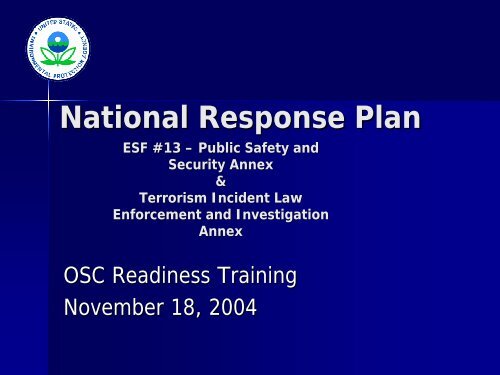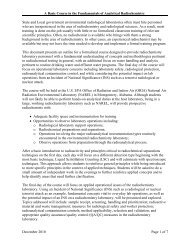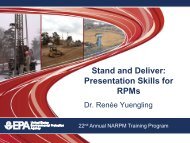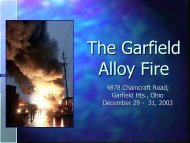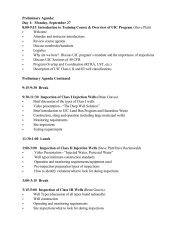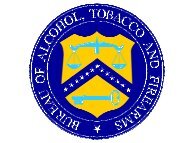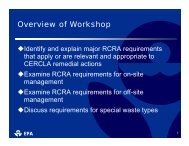ESF #13 - Public Safety and Security Annex.&.Terrorism Incident ...
ESF #13 - Public Safety and Security Annex.&.Terrorism Incident ...
ESF #13 - Public Safety and Security Annex.&.Terrorism Incident ...
- No tags were found...
You also want an ePaper? Increase the reach of your titles
YUMPU automatically turns print PDFs into web optimized ePapers that Google loves.
National Response Plan<strong>ESF</strong> <strong>#13</strong> – <strong>Public</strong> <strong>Safety</strong> <strong>and</strong><strong>Security</strong> <strong>Annex</strong>&<strong>Terrorism</strong> <strong>Incident</strong> LawEnforcement <strong>and</strong> Investigation<strong>Annex</strong>OSC Readiness TrainingNovember 18, 2004
<strong>ESF</strong> <strong>#13</strong> <strong>Public</strong> <strong>Safety</strong> <strong>and</strong> <strong>Security</strong><strong>Annex</strong>! <strong>ESF</strong> Coordinators: Department of Homel<strong>and</strong> <strong>Security</strong> ANDDepartment of Justice! Primary Agencies: Department of Homel<strong>and</strong> <strong>Security</strong> ANDDepartment of Justice! Support Agencies:Department of AgricultureDepartment of CommerceDepartment of DefenseDepartment of EnergyDepartment of the InteriorDepartment of Veterans AffairsEnvironmental Protection AgencyNASASocial <strong>Security</strong> AdministrationU.S. Postal Service
<strong>ESF</strong> <strong>#13</strong> <strong>Public</strong> <strong>Safety</strong> <strong>and</strong> <strong>Security</strong>Purpose <strong>and</strong> Scope! Integrates Federal public safety <strong>and</strong> security capabilities <strong>and</strong>resources to support the full range of incident managementactivities associated with potential or actual <strong>Incident</strong>s ofNational Significance (INS)! Federal to Federal support or Federal support to State or localauthorities to include non-investigative/non-criminal lawenforcement, public safety, <strong>and</strong> security capabilities <strong>and</strong>resources during potential or actual INSs! Examples: Force <strong>and</strong> critical infrastructure protection, securityplanning <strong>and</strong> technical assistance, technology support, <strong>and</strong>public safety in both pre-incident <strong>and</strong> post-incident situations
<strong>ESF</strong> <strong>#13</strong> <strong>Public</strong> <strong>Safety</strong> <strong>and</strong> <strong>Security</strong>Policies! State, local, tribal, private-sector, <strong>and</strong> specific Federalauthorities have primary responsibility for public safety <strong>and</strong>security-first line of response <strong>and</strong> support! In most situations, local jurisdictions have primary authority<strong>and</strong> responsibility for law enforcement activities using ICS. Inlarge scale incidents…additional resources should first beobtained via mutual aid agreements with neighboring localitiesor state resources-Unified Comm<strong>and</strong>! Through <strong>ESF</strong> <strong>#13</strong> Federal resources supplement whenrequested or required-NIMS
<strong>ESF</strong> <strong>#13</strong> <strong>Public</strong> <strong>Safety</strong> <strong>and</strong> <strong>Security</strong>Policies! <strong>ESF</strong> <strong>#13</strong> primary agencies facilitate coordination amongsupporting agencies! <strong>ESF</strong> <strong>#13</strong> coordinates the implementation of Federal authoritiesthat are appropriate for the situation! Relationship to NRP <strong>Terrorism</strong> <strong>Incident</strong> Law Enforcement <strong>and</strong>Investigation <strong>Annex</strong>: As the lead LEO in the United States, theAttorney General, generally acting through the FBI, maintainsthe lead for criminal investigations of terrorist acts or terroristthreats by individuals or groups inside the U.S., or directed atU.S. citizens or institutions abroad – All <strong>ESF</strong> <strong>#13</strong> activitiescoordinated through AG
<strong>ESF</strong> <strong>#13</strong> <strong>Public</strong> <strong>Safety</strong> <strong>and</strong> <strong>Security</strong>Policies! In the event that State or local police forces (including theNational Guard) are unable to adequately respond to a civildisturbance, the State legislature may request, through the AG,Federal military assistance under 10 U.S.C. Chapter 15.! The President may also use the military in a state to enforceFederal law or to protect constitutional rights. (DOD <strong>and</strong> DOJcoordination procedures during responses to law enforcementemergencies are set forth in DOD Civil Disturbance Plan,February 15, 1991)! *This annex does not usurp or override the policies or mutualaid agreements of any local, or tribal jurisdiction orgovernment, State government or Federal agency. LE activities<strong>and</strong> criminal investigations are conducted in conformance withexisting codes <strong>and</strong> statutes.
<strong>ESF</strong> <strong>#13</strong> <strong>Public</strong> <strong>Safety</strong> <strong>and</strong> <strong>Security</strong>Relationship to Other Plans:! <strong>ESF</strong> <strong>#13</strong> Incorporates the existing network of public safety <strong>and</strong>security interagency plans:National Infrastructure Protection PlanSector-Specific PlansNational Maritime <strong>Security</strong> PlanArea Maritime <strong>Security</strong> PlansVessel <strong>and</strong> Facility <strong>Security</strong> Plans
<strong>ESF</strong> <strong>#13</strong> <strong>Public</strong> <strong>Safety</strong> <strong>and</strong> <strong>Security</strong>Relationship to Other Plans:! <strong>ESF</strong> <strong>#13</strong> Incorporates the existing network of public safety <strong>and</strong>security interagency plans:National Infrastructure Protection PlanSector-Specific PlansNational Maritime <strong>Security</strong> PlanArea Maritime <strong>Security</strong> PlansVessel <strong>and</strong> Facility <strong>Security</strong> Plans
<strong>ESF</strong> <strong>#13</strong> <strong>Public</strong> <strong>Safety</strong> <strong>and</strong> <strong>Security</strong>Concept of Operations! <strong>ESF</strong> <strong>#13</strong> is activated when Federal public safety <strong>and</strong> securitycapabilities or resources are needed to support incidentoperations. Includes threat or pre-incident as well as postincidentsituations.! Actions:HeadquartersWhen activated, primary agencies deploy rep to NationalResponse Coordination Center (NRCC) at HSOCAssess the need for <strong>ESF</strong> <strong>#13</strong> resources <strong>and</strong> coordinateresponse assistance <strong>and</strong> support in closecooperation with regional <strong>and</strong> field <strong>ESF</strong> <strong>#13</strong>elementsMay convene a conference call with supporting agenciesMay provide subject matter experts to the IIMG <strong>and</strong> othervarious special teams (ERT-A, etc.)
<strong>ESF</strong> <strong>#13</strong> <strong>Public</strong> <strong>Safety</strong> <strong>and</strong> <strong>Security</strong>Concept of Operations! Actions:Headquarters (continued)During terrorism incidents, <strong>ESF</strong> <strong>#13</strong> activities will be closelycoordinated with the FBI Strategic Information <strong>and</strong>Operations Center (SIOC) <strong>and</strong> the National Joint <strong>Terrorism</strong>Task Force (NJTTF)*SIOC works in coordination with HSOC <strong>and</strong> IIMG
<strong>ESF</strong> <strong>#13</strong> <strong>Public</strong> <strong>Safety</strong> <strong>and</strong> <strong>Security</strong>Concept of Operations! Actions:Regional <strong>and</strong> Field Levels:<strong>ESF</strong> <strong>#13</strong> rep may participate in assessment efforts of ERT-AWhen <strong>ESF</strong> <strong>#13</strong> is activated, the on-call rep of primaryagencies deploy to Regional ResponseCoordination Center (RRCC) <strong>and</strong> coordinates untilJFO is established<strong>ESF</strong> <strong>#13</strong> is included in the Operations Section of the RRCC<strong>and</strong> JFODuring terrorism incidents, <strong>ESF</strong> <strong>#13</strong> activities are managedfrom the FBI Joint Operations Center (JOC) prior toJFO, but closely coordinated with the RRCC. AfterJFO, <strong>ESF</strong> <strong>#13</strong> goes to JFO Operations Section
<strong>ESF</strong> <strong>#13</strong> <strong>Public</strong> <strong>Safety</strong> <strong>and</strong> <strong>Security</strong>Concept of Operations! Actions:Regional <strong>and</strong> Field Levels (continued):During non- terrorism incidents, <strong>ESF</strong> <strong>#13</strong> activities aremanaged from the RRCC <strong>and</strong> later the JFO. All <strong>ESF</strong><strong>#13</strong> activities are closely coordinated with the localFBI field office <strong>and</strong> Joint <strong>Terrorism</strong> Task Force (JTTF).JFO Coordination Group will resolve resource <strong>and</strong> missionconflicts involving Federal public safety <strong>and</strong> security assetsengaged in emergency operations.
<strong>ESF</strong> <strong>#13</strong> Concept of Operations! Actions:<strong>Incident</strong> Management Activities:<strong>ESF</strong> <strong>#13</strong> provides Federal public safety <strong>and</strong> security assistanceto support prevention, preparedness, response, <strong>and</strong> recoverypriorities when locally available assets are overwhelmed orinadequate, or where unique Federal capability is required.Pre-<strong>Incident</strong> CoordinationTechnical Assistance (e.g., Vas risk analyses)<strong>Public</strong> <strong>Safety</strong> <strong>and</strong> <strong>Security</strong> Assessment (e.g., mapping,modeling)Badging <strong>and</strong> CredentialingForce Protection (e.g., responders <strong>and</strong> other workers)<strong>Security</strong> SurveillanceSpecialized <strong>Security</strong> Resources (e.g., CBRN <strong>and</strong> explosivesdetection devices, LEO personal protective gear, etc.)
<strong>ESF</strong> <strong>#13</strong> Concept of Operations! Responsibilities<strong>ESF</strong> Coordinators/Primary Agencies:! Coordinate preparedness activities with <strong>ESF</strong> <strong>#13</strong> supportingagencies! Provide expertise to IIMG when requested! Maintain close coordination during operations betweenaffected regions, NRCC (HSOC) other <strong>ESF</strong>s, local JTTFs <strong>and</strong>the NJTTF, as required! De-conflict any potential overlap issues re missionassignments! Resolve conflicting dem<strong>and</strong>s for resources <strong>and</strong> expertise.! Coordinate backup support from other regions of country
<strong>ESF</strong> <strong>#13</strong> Concept of Operations! Responsibilities<strong>ESF</strong> Support Agencies:*Each support agency maintains its authority.! Staff HSOC, NRCC, RRCC, <strong>Incident</strong> Comm<strong>and</strong> Post, JFO,Joint Information Center, FBI SIOC or FBI JOC (for terrorismincidents)! Provide periodic reports, regarding agency responseoperations to the JFO Planning Section! Provide technical <strong>and</strong> subject-matter expertise, data, advice,<strong>and</strong> staff support for operations that fall within the domain ofeach agency.
<strong>ESF</strong> <strong>#13</strong> Concept of Operations! Agencies/Functions! USDA/Forest Service! Commerce/ NOAA, National Weather Service, Office ofOceanic <strong>and</strong> Atmospheric Research! DOD/U.S. Army Corps of Engineers! Energy! Homel<strong>and</strong> <strong>Security</strong>/U.S. Secret Service, U.S. Coast Guard,Directorate of Border <strong>and</strong> Transportation <strong>Security</strong> (BTS),Customs <strong>and</strong> Border Protection, Immigration <strong>and</strong> CustomsEnforcement (ICE), Transportation <strong>Security</strong> Administration(TSA), Science <strong>and</strong> Technology Directorate (S&T),Information Analysis <strong>and</strong> Infrastructure ProtectionDirectorate (IAIP)! Interior! Veterans’ Affairs
<strong>ESF</strong> <strong>#13</strong> Concept of Operations! Agencies/Functions! EPA/Office of Criminal Enforcement, Forensics, <strong>and</strong> Training(OCEFT), Criminal Investigation Division (CID), NationalEnforcement Investigations Center (NEIC), National CounterterrorismEvidence Response Team (NCERT), Counter<strong>Terrorism</strong> Response Team (CTRT)! NASA! SSA! U.S. Postal Service
<strong>Terrorism</strong> <strong>Incident</strong> Law Enforcement<strong>and</strong> Investigation <strong>Annex</strong>! Coordinating Agency:Department of Justice/Federal Bureau of Investigation! Cooperating Agencies:Department of DefenseDepartment of EnergyDepartment of Health <strong>and</strong> Human ServicesDepartment of Homel<strong>and</strong> <strong>Security</strong>Department of StateEnvironmental Protection Agency
<strong>Terrorism</strong> <strong>Incident</strong> <strong>Annex</strong>Purpose <strong>and</strong> Scope! The purpose of this annex is to facilitate an effective Federallaw enforcement <strong>and</strong> investigative response to all threats oracts of terrorism within the United States, regardless ofwhether they are deemed credible <strong>and</strong>/or whether they escalateto an INS. This annex establishes the structure for asystematic, coordinated, unified, timely, <strong>and</strong> effective nationallaw enforcement <strong>and</strong> investigative response to threats or actsof terrorism within the United States.! Provides planning guidance <strong>and</strong> outlines operational conceptsfor the Federal law enforcement <strong>and</strong> investigative response to athreatened or actual terrorist incident within the United States.! Acknowledges <strong>and</strong> outlines the unique nature of each threat orincident, the capabilities of local jurisdictions, <strong>and</strong> the lawenforcement <strong>and</strong> investigative activities necessary to preventor mitigate a specific threat or incident.
<strong>Terrorism</strong> <strong>Incident</strong> <strong>Annex</strong>Policies! This annex provides overall guidance to Federal, State, local,<strong>and</strong> tribal agencies concerning the Federal Government’s lawenforcement <strong>and</strong> investigative response to potential or actualterrorist threats or incidents that occur in the United States,particularly those involving weapons of mass destruction(WMD), or chemical, biological, radiological, nuclear, or highexplosive(CBRNE) material.! Federal Agencies:! The following Federal agencies have primary responsibilityfor certain aspects of the overall law enforcement <strong>and</strong>investigative response:DOD, DOE, HHS, DHS, FBI, EPA
<strong>Terrorism</strong> <strong>Incident</strong> <strong>Annex</strong>Policies! According to HSPD-5, “The Attorney General has lead responsibilityfor criminal investigations of terrorist acts or terrorist threats byindividuals or groups inside the United States, or directed at U.S.citizens or institutions abroad, where such acts are within the Federalcriminal jurisdiction of the United States…! Generally acting through the FBI, the Attorney General, in cooperationwith other Federal departments <strong>and</strong> agencies engaged in activities toprotect our national security, shall also, coordinate the activities of theother members of the law enforcement community to detect, prevent,preempt, <strong>and</strong> disrupt terrorist acts against the United States.Following a terrorist threat or an actual incident that falls within thecriminal jurisdiction of the U.S., the full capabilities of the U.S. shall bededicated, consistent with U.S. law…to assisting the Attorney Generalto identify the perpetrators <strong>and</strong> bring them to justice.”
<strong>Terrorism</strong> <strong>Incident</strong> <strong>Annex</strong>Deployment/Employment Priorities! First priority of Operations: Preserving life or minimizing risk to health! Preventing a threatened act from being carried out or an existingterrorist act from being exp<strong>and</strong>ed or aggravated! Locating, accessing, rendering safe, controlling, containing,recovering, or disposing of a WMD that has not yet functioned, <strong>and</strong>disposing of CBRNE material in coordination with appropriatedepartments <strong>and</strong> agencies (e.g., DOD, DOE, EPA)! Apprehending <strong>and</strong> successfully prosecuting perpetrators of terroristthreats or incidents
<strong>Terrorism</strong> <strong>Incident</strong> <strong>Annex</strong>Planning Assumptions <strong>and</strong> Considerations! A terrorist threat or incident may occur at any time of day with little orno warning, may involve single or multiple geographic areas, <strong>and</strong> mayresult in mass casualties.! The suspected or actual involvement of terrorists adds a complicatingdimension to incident management.! The response to a threat or actual incident involves FBI lawenforcement <strong>and</strong> investigative activity as an integrated element! In the case of a threat, there may be no incident site, no externalconsequences…there may be no need for traditional ICS elements(e.g., <strong>Incident</strong> Comm<strong>and</strong> Post, JFO)! An act of terrorism…may overwhelm capabilities of State, local, tribal,governments <strong>and</strong> may seriously challenge existing Federal responsecapabilities
<strong>Terrorism</strong> <strong>Incident</strong> <strong>Annex</strong>Planning Assumptions <strong>and</strong> Considerations! In the case of a biological attack, the effect may be temporally <strong>and</strong>geographically dispersed, with no clearly defined “incident site”.! A biological attack employing a contagious agent may requirequarantine by Federal, States, local, <strong>and</strong> tribal health officials, tocontain the disease outbreak.! If appropriate personal protective equipment <strong>and</strong> capabilities are notavailable <strong>and</strong> the area is contaminated with CBRNE or otherhazardous materials, it is possible that response actions into acontaminated area may be delayed until the material has dissipated toa level that is safe for emergency response personnel to operate oruntil appropriate personal protective equipment <strong>and</strong> capabilitiesarrive, whichever is sooner.
<strong>Terrorism</strong> <strong>Incident</strong> <strong>Annex</strong>Situation! The resolution to an act of terrorism dem<strong>and</strong>s an extraordinarylevel of coordination of law enforcement, criminal investigation,protective activities, emergency management functions, <strong>and</strong>technical expertise across all levels of government. Theincident may affect a single location or multiple locations, eachof which may be an incident scene, a hazardous scene, <strong>and</strong>/ora crime scene simultaneously.
<strong>Terrorism</strong> <strong>Incident</strong> <strong>Annex</strong>Concept of Operations/Comm<strong>and</strong> <strong>and</strong> Control! The FBI is the lead agency for criminal investigations ofterrorist acts or terrorist threats <strong>and</strong> intelligence collectionactivities within the United States. Investigative <strong>and</strong>Intelligence activities are managed by the FBI from an FBIcomm<strong>and</strong> post or Joint Operations Center (JOC). FBI SpecialAgent in Charge (SAC) of the local field office establishes thecomm<strong>and</strong> post.! JOC generally consists of three functional groups (unlessincident involved WMD/CBRNE materials-then a fourth groupmay be incorporated):! Comm<strong>and</strong> Group! Operations Group! Operations Support Group! *Consequence Management Group*In an incident involving WMD or CBRNE material
<strong>Terrorism</strong> <strong>Incident</strong> <strong>Annex</strong>Concept of Operations/JOC! JOC is an interagency comm<strong>and</strong> <strong>and</strong> control center used formanaging multiagency preparation for, <strong>and</strong> the lawenforcement <strong>and</strong> investigative response to, a credible terroristthreat or incident.! Similar to Area Comm<strong>and</strong> concept within ICS, to coordinate<strong>and</strong> organize multiple agencies <strong>and</strong> jurisdictions during criticalincidents or special events. JOC is modular <strong>and</strong> scalable tomeet specific operational requirements.! JOC may be established in pre-incident, pre-emptive role insupport of a significant special event.
<strong>Terrorism</strong> <strong>Incident</strong> <strong>Annex</strong>Concept of Operations/JOC! Law enforcement/public safety functions are managed throughthe Operations Section of the ICS.! Criminal investigation <strong>and</strong> the collection, analysis,dissemination of intelligence are sensitive law enforcementoperations that require a secure environment <strong>and</strong> well-definedorganizational management structure.! JOC provides mechanisms for controlling access to <strong>and</strong>dissemination of sensitive or classified information.! Management of crisis information <strong>and</strong> intelligence isrecognized under the NIMS as a sixth functional area withinICS.
<strong>Terrorism</strong> <strong>Incident</strong> <strong>Annex</strong>Concept of Operations/Comm<strong>and</strong> <strong>and</strong> Control! Comm<strong>and</strong> Group: Provides recommendations <strong>and</strong> advice to theFBI SAC regarding the development <strong>and</strong> implementation ofstrategic situations to resolve the situation.! Strategic Legal Team! Joint Information Center (JIC)! Domestic Emergency Support Team (DEST)
! Field Operations Units! Evidence Response! WMD/CBRNE! Surveillance! Technical<strong>Terrorism</strong> <strong>Incident</strong> <strong>Annex</strong>Concept of Operations/Comm<strong>and</strong> <strong>and</strong> Control! Operations Group: H<strong>and</strong>les all investigative, intelligence, <strong>and</strong>operational functions related to the threat, critical incident, orspecial event.! Information Control Unit! Intelligence Unit! FBI/SIOC! DHS/HSOC! JFO Coordination Group! Investigations Unit
<strong>Terrorism</strong> <strong>Incident</strong> <strong>Annex</strong>Concept of Operations/Comm<strong>and</strong> <strong>and</strong> Control! Operations Support Group: Units are based on the specificneeds of the threat, critical incident, or special event. Staffed bysubject matter experts in specialized areas.! Administrative Unit! Logistics Unit! Legal Unit! Media Unit! Liaison Unit! Communications Unit! Information Technology Unit
<strong>Terrorism</strong> <strong>Incident</strong> <strong>Annex</strong>Concept of Operations/Comm<strong>and</strong> <strong>and</strong> Control! Consequence Management Group: Consists of representativesof agencies that provide consequence-focused expertise insupport of law enforcement activities. JOC does not manageconsequence functions; it ensures law enforcement activitieswith emergency management implications are communicated<strong>and</strong> coordinated to appropriate personnel in a complete <strong>and</strong>timely manner.! FBI <strong>and</strong> DHS representatives screen threat/incidentintelligence for the Consequence Management Group.! Agencies comprising the CMG may also have personnelassigned to other units within the JOC structure. (OtherSpecialized Units)
<strong>Terrorism</strong> <strong>Incident</strong> <strong>Annex</strong>Concept of Operations/Comm<strong>and</strong> <strong>and</strong> Control! When, in the determination of the Secretary of Homel<strong>and</strong><strong>Security</strong>, in coordination with the Attorney General, the incidentbecomes an incident of National Significance <strong>and</strong> a JFO isestablished, the JOC becomes a section of the JFO <strong>and</strong> the FBISAC becomes the Senior Federal Law Enforcement Official(SFLEO) in the JFO Coordination Group. In this situation, theJOC Consequence Management Group is incorporated into thecomponents of the JFO (see NRP Base Plan, Figure 4 <strong>and</strong>figure 7).
<strong>Terrorism</strong> <strong>Incident</strong> <strong>Annex</strong>Concept of Operations/The Response! Upon receipt of a threat of terrorism within the U.S., the FBIconducts a formal threat credibility assessment in support ofoperations with assistance from select interagency experts.! For a WMD or CBRNE threat, this assessment includes threeperspectives:! Technical Feasibility! Operational Practicability! Behavioral Resolve
<strong>Terrorism</strong> <strong>Incident</strong> <strong>Annex</strong>Concept of Operations/The Response! Upon receipt of a threat of terrorism within the U.S., the FBIconducts a formal threat credibility assessment in support ofoperations with assistance from select interagency experts.! If threat is credible-prevent or resolve the threat. Tailor theresponse actions.! Threat Assessments:! Presence of CBRNE device or WMD capable of causingsignificant damage confirmed?! After an incident occurs, threat assessment is focused oncriminal intent, extent of the threat, <strong>and</strong> the likelihood ofsecondary devices
<strong>Terrorism</strong> <strong>Incident</strong> <strong>Annex</strong>Concept of Operations/The Response! Upon determination of credible threat, FBI Headquartersactivates SIOC to coordinate <strong>and</strong> manage national-levelsupport to a terrorism incident (SIOC generally mirrors JOCstructure in the field).! SIOC is staffed by liaison officers from other Federal agencieswho coordinate with <strong>and</strong> provide assistance to the FBI.! Maintain direct connectivity with HSOC! HSOC may activate NRP components in coordination with theFBI once notified of a credible threat.! DEST deployment will be considered
<strong>Terrorism</strong> <strong>Incident</strong> <strong>Annex</strong>Concept of Operations/The Response! When an incident occurs <strong>and</strong> an ICP is established on scene, FBIpersonnel integrate into the ICP. Three specific position within theICP are provided:! The first FBI Special Agent (SA) or Joint <strong>Terrorism</strong> Task Force(JTTF) member responding receives the initial briefing from the IC<strong>and</strong> works closely with the IC as a member of Unified Comm<strong>and</strong>.The FBI rep then informs the local FBI Field Office of the currentsituation. When a more senior FBI SA arrives on the scene he/sheassumes the role of the FBI rep to the Unified Comm<strong>and</strong>.! The first arriving SA or JTTF member moves to the OperationsSection as the Deputy Chief of Operations to manage Federal lawenforcement <strong>and</strong> investigative assets in support to the <strong>Incident</strong>Action Plan! An additional FBI SA assumes the position of Deputy Chief ofPlanning within the ICP.
National Response Plan<strong>ESF</strong> <strong>#13</strong> <strong>Public</strong> <strong>Safety</strong> <strong>and</strong> <strong>Security</strong> <strong>Annex</strong><strong>Terrorism</strong> <strong>Incident</strong> Law Enforcement<strong>and</strong> Investigation <strong>Annex</strong>Ted J. StanichSenior CoordinatorHomel<strong>and</strong> <strong>Security</strong> ProgramOffice of Criminal Enforcement,Forensics, <strong>and</strong> TrainingU.S. EPATel: 202 564-5484


